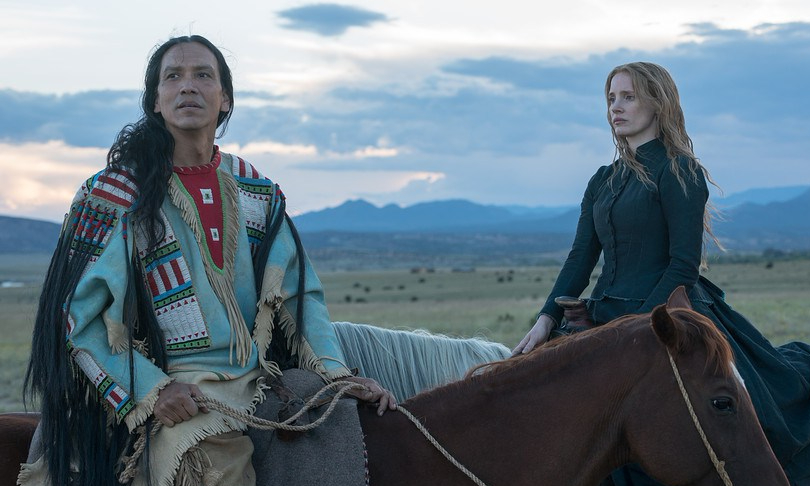Woman Walks Ahead purports to tell the true story of the relationship between Sitting Bull (Michael Greyeyes) and Catherine Weldon (Jessica Chastain), a portrait artist who travels out of New York to Dakota in order to be the first to paint the famous Sioux leader Sitting Bull’s portrait. She arrives at a contentious time. Sitting Bull has become a farmer, and the U.S. military is seeking to enforce a land treaty on the Sioux that would effectively shift control over large sections of Sioux land to white landholders—a treaty further facilitated by the ongoing threat of war. On the train to Dakota, she’s warned off by Colonel Silas Grove (Sam Rockwell), who tells her to go back to New York. He also introduces the viewer to the political situation— the American military is chafing for revenge for Little Big Horn, and the peace between white settlers and the native population is contentious at best. Catherine walks into the middle of it all, wanting to paint a portrait, and winds up falling for Sitting Bull.
The difficulty with Woman Walks Ahead is that its very subject falls into the trap of white saviorism, which the film only occasionally manages to avoid. Catherine is a naïve figure at first, functioning as the viewer’s introduction to the fraught world of the Sioux and their very tendentious relationship with the American military occupiers. Catherine’s naïveté is initially understandable– she’s a sheltered upper middle class white woman from New York, drawn to Sitting Bull and the Sioux as part of a romantic, artistic narrative. Her sense of entitlement and the romance of the “noble savage” is punctured quickly – first when she’s robbed soon after getting off the train, and then again at her introduction to Sitting Bull through his nephew (Chaske Spencer), a tribal police officer. The full arc of Catherine coming to understand the dangerous political situation she’s injected herself into is unique one, and has the potential to question the underlying white savior problem…if the film went that far. But it quickly falls back on well-worn tropes that have been rightly criticized for the romanticizing of American Indians on the one hand, and an almost fetishistic indulgence in their suffering on the other.

The fact is that Woman Walks Ahead can’t possibly end well. We know what happens to the Sioux. We know what happens to Sitting Bull, and to the land treaty. We know what happens at Wounded Knee. And Catherine, presented as an intelligent and capable woman in her own right, never quite sheds her naïveté in a believable way. She believes to the last that the political process will somehow protect the Sioux, that the American government will abide by the rule of law, and that the military – made up of white men enraged by decades of war, violent racism, and an undying sense of being right – will somehow do the right thing. Yet this naïveté doesn’t entirely ring true, not after the degrees of violence and complex political situations to which Catherine is exposed.
Maybe that’s ultimately a strength. Maybe the film is seeking to undermine the white savior motif by depicting a white person who cannot, no matter how hard she tries, save a people, and whose very naïve faith in her own government works against her. But Woman Walks Ahead would have done well to focus more on the complexity of the political and social dialogue at work – represented, in turns, by Colonel Grove, General Cook, and the commanding officer on the one hand, Sitting Bull, his nephew, and the other Sioux elders on the other, with Catherine as the arbiter. But the film veers off into a somewhat confused love story that, while moving, doesn’t do much to reveal the depths of tragedy and anger at the base of this story.
Yet there’s a lot to recommend Woman Walks Ahead. The performances are uniformly excellent, especially from the two leads, who create a complicated and fractious relationship that slowly morphs into respect and love. Chastain is always a pleasure to watch, but here she actually takes a step back at times, as the film comes to focus more on Sitting Bull and his dilemma in protecting his people, and knowing—better than Catherine—that there may not be any good outcome for the Sioux. Greyeyes is interesting to watch, even if he sometimes functions more as a guide through Indian Country and less as a legendary leader.
The use of Sioux dialogue throughout is one of several things that made me more willing to go along with the triter aspects of Woman Walks Ahead. In a particularly powerful sequence, Sitting Bull gives a speech about the future of the Sioux people and the choices they have to make. Rather than substituting in subtitles or filtering the translation of the speech through a white speaker, the speech is translated, in real time, by the commanding officer’s Sioux wife, who speaks both languages. It’s a powerful moment in an only occasionally powerful film.
Woman Walks Ahead doesn’t accomplish all that it could, but it’s far from a bad film, or even a mediocre one. It avoids over-romanticizing the American West, even as it trades on romance, and succeeds in creating sympathy for both the white and the Sioux characters, in varying degrees. Watching it, I felt like there was much more to the story, hanging there at the peripheries. But the most terrifying thing in this film is a group of white men with guns…and that, somehow, says an awful lot.
Woman Walks Ahead is currently at the Tribeca Film Festival, April 25-29

Lori Hopkins
“Noble savage”? Seriously?
Lauren
That’s the trope that is in play, yes, hence the quotation marks. It is also the trope that gets punctured pretty quickly in the film.